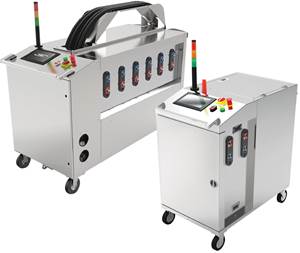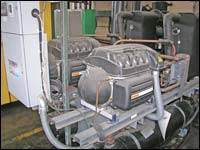NPE 2006 News Wrap-Up: Fluid Temperature Control: Saving on Energy and Maintenance
At NPE in Chicago, chillers and TCUs were put on a lean energy diet and redesigned for greater durability. Suppliers also added features while taking out cost.
The news in chillers, mold-temperature-control units (TCUs), cooling towers, and related equipment was somewhat sparse at this year’s NPE show. The biggest news was the proliferation of vendors and models of central chillers utilizing a new type of quiet, energy-saving compressor. There was also the arrival of a new supplier of chillers and TCUs to the U.S. market, bringing a new concept designed to save energy and maintenance costs. Three firms brought out their first TCU lines and one made its debut in cooling towers. Some low-cost equipment from Asia, or based on Asian components, also appeared at the show.
In addition, the industry trend toward increased utilization of stainless steel—at little or no cost increase—was evident in cooling equipment as in other auxiliaries. Likewise, color touchscreen control interfaces are becoming more widespread, though not yet to the overwhelming degree seen in other auxiliary equipment.
Energy-saving chillers
The biggest news in chillers in the last few years was the arrival of a new type of compressor, variously described as “frictionless” or “oil-less,” built by Danfoss Turbocor Compressors Inc. of Montreal. It has only one moving part, a shaft that turns on magnetic bearings that “levitate” the shaft, eliminating friction and wear and greatly reducing noise. The variable-speed motor is also said to save energy (up to 35%), and the overall unit is more compact than other units (see “Learn More” box).
On the other hand, this type of compressor is 20% to 25% more expensive, and chiller manufacturers generally agree that its energy efficiency relative to conventional chillers pays off only if it will run under less than maximum load a significant amount of the time.
Up to now, the Turbocor compressor has been available for central chillers of 60 to 190 tons. At show time, Danfoss Turbocor was said to have just come out with a model for chillers of 200 to 300 tons.
The first plastics chiller using this type of compressor was introduced in late 2004 by Thermal Care. A year later, a chiller built by a large HVAC supplier, McQuay International in Minneapolis, was brought to the plastics market by AEC and Sterling. At the show, Advantage Engineering introduced its WMC Series, also built by McQuay, in 120 to 180 tons. And Cooling Technology joined Thermal Care in building its own chiller based on the Turbocor compressor. Its CT Series comes in 75 to 90 tons, and models up to 140 tons are in development. The company claims energy savings as high as 40% to 60%.
Up to now, all chillers using the Turbocor compressor have been water cooled. But Thermal Care recently announced a version based on an outdoor, air-cooled remote condenser, which reportedly can save even more energy.
Energy and maintenance savings are also promised by a cooling approach that has proven successful in Europe and Latin America but is new to North America. Marketed here by Frigel North America, a new Chicago-area branch of an Italian firm, the EcoDry “fluid cooler” system substitutes for maintenance-prone cooling towers and energy-consuming central chillers. It uses an outdoor heat exchanger to cool the plant water and individual portable chillers or TCUs (also supplied by Frigel) to fine-tune the water temperature and flow rate for individual machines. (Frigel also supplies a combination chiller/TCU.) A major advantage claimed for this “dry-cooling” system is that the process water is kept in a closed circuit and not exposed to the air. It thus stays clean without need for chemical treatments, does not deposit scale, and needs very little make-up water (see “Learn More” box).
More new chillers
AEC came out with new RS1 Series central chillers in five models from 30 to 100 tons. Aimed more at extrusion than molding plants, these are economical models with a single circuit, costing up to 35% less than dual-circuit models. They have a rotary screw compressor and new shell-and-tube evaporator and condenser. Also new is an Allen-Bradley PLC controller and small color touchscreen. (A new advanced multi-chiller touchscreen control is also available.)
Advantage unveiled its newly repackaged Maximum portable chillers with a new, simple M1 controller and touchscreen display. The company displayed 2-ton, 10-ton, and just-released 20-ton models.
New from Mokon are outdoor air-cooled central chillers, which free up indoor space. They are designed for ambient temperatures of 0° F to 115 F and come in 10- to 500-ton capacities. They are factory-wired and pre-tested and mounted on frames designed for easy mechanical lifting.
In addition, Mokon now supplies stainless steel as the standard construction (formerly optional) for its pump tanks. The company also offers two new controls as standard options. One is a new Eurotherm controller for its complete line of chillers and TCUs. Its 1/16 DIN size is smaller, and it has a dual LCD display of set and actual fluid temperatures, plus auto air purge and self-tuning. Mokon also offers controls from Carel of Italy on its central and portable chillers. One version has LED readout of set and actual temperatures plus built-in capacity control of compressors and condenser fans, and built-in delay functions. Another version has a programmable touchscreen with plain-English alarm messages and instructions for fixing problems. It also indicates hours of operation and date of last maintenance. Mokon also claims to be the first supplier of circulating-fluid temperature controls to provide UL-la beled electrical sub-panels as standard on all its equipment.
A central PLC system with color touchscreen is new from Sterling. It can handle any number and any brand of circulating water or oil systems.
Hot water & oil TCUs
NPE saw three companies begin offering TCUs for the first time:
- Colortronic entered this field with a brand-new economical water TCU called the ECU Series. It is very compact (about 12 x 23 in.), heats to 250 F, and has a cast-iron pump of 0.75 to 7.5 hp.
- Comet Automation introduced its first TCUs, which it assembles from Chinese components as well as corrosion-free pumps from Speck in Germany. Wetted components are stainless steel, copper, or brass. Hot-water units have 6 or 9 kw and operate at up to 356 F. Hot-oil units operate at up to 356 F with 6 or 9 kw. Water-or-oil models have 6 or 15 kw and heat water to 194 F and oil to 302 F. Dual zones are available. Some models operate in pressure or suction mode. Comet plans to introduce portable chillers later on.
- Motan brought out Motemp TCUs (built by Regloplas in Switzerland) for hot water, pressurized water, and oil. They heat water to 284 F and oil to to 572 F. They have heaters of 6 and 9 kw and pumps of 0.7 to 1.5 hp. Suction and leak-stop mode is standard for non-pressurized units. Motan also offers two descaling units, a corrosion inhibitor, and a hot-oil system-cleaner additive.
In other news, Sterling introduced a compact 320 F water TCU with “no-seal/no-leak” magnetic-drive dual pumps.
Mokon introduced what it says is the first hot-water TCU with stainless steel as the main component for wetted surfaces instead of cast iron and carbon steel. Compact Hydrotherm II units have 9-kw and 25-gpm capacity and occupy about 2 sq ft. They heat up to 250 F.
Also new from Mokon is the redesigned HF-2 Series hot-oil system, which is more compact and 12% to 36% lower in cost than previous units. It has a new 12-kw heater manifold and all-welded construction said to eliminate leaks at high temperature and high flow rates. It comes with single or dual zones and 40 or 60 gpm capacity. Maximum temperature is 600 F.
Since the last NPE, Budzar Industries has offered economically priced portable chillers and TCUs built by Shini of Taiwan. Sold under the Budzar World Alliance (BWA) label, air- and water-cooled chillers from 3 to 30 tons start at $3397 and can be purchased online. BWA hot-water units have 1 to 3 hp and 9 to 18 kw heaters. Prices range from $1077 to $2154, and they can be purchased online. Also available are two hot-oil units (9 and 12 kw) for up to 550 F. Both have Omron controls and German Speck magnetic “seal-less” drives. Prices are $4695 and $4995.
Opti Temp reports that it is developing remote troubleshooting capability via the internet for its chillers and combination water chiller/heater units. The company is also working with RJG Inc., Traverse City, Mich., to provide a monitoring and control interface to RJG’s eDart injection molding machine controller.
As reported in June, Wittmann redesigned its Tempro Basic C 90 and Primus C 90 units for water up to 200 F, providing increased mold-purging capacity (with 40% larger tanks) and automatic cooldown before tool changes. These improvements do not increase the price ($1395) of the lower-cost Primus C 90, while the Tempro Basic version actually costs 14% less than before.
Cooling towers and more
Mokon introduced its first line of cooling towers in galvanized steel or one-piece HDPE. They are available with 10 to 500 tons capacity. Galvanized towers have an induced-draft, cross-flow design, while HDPE models come in forced-draft or induced-draft versions, depending on size.
One of two new products from Burger & Brown Engineering is a high-pressure version of the firm’s hot-water/oil flowmeter. It withstands 150 psi and 500 F. The body is all stainless steel. Also, the scale on the cover now displays percentage of maximum flow instead of gallons or liters/min. That allows technicians to adjust the internal resistance spring without having to change the scale.
The second introduction was the new Ferrogard magnetic filtration system for removing metal fines from circulating water. It reportedly does not restrict flow.
Other news in water filtration and treatment is the arrival of TowerKlean II (or TK2) from TowerKlean LLC. Like the original model, this one uses a patented bimetallic process media to prevent scale formation, remove existing scale, control biological fouling, and inhibit corrosion—all without chemicals. The media is changed just once a year. What’s new about TK2 is that it handles double the water volume while taking up less space. A new pivoting vessel makes media changing easier. A new screen filter replaces the previous sand bed, thereby reducing the backwashing cleaning cycle from 90 sec to 12 sec. There’s also a new conductivity meter to monitor water quality.
Related Content
Descaling Pump Cleans Heating and Cooling Circuits
Mouldpro’s compact and portable descaling pump keeps heating and cooling circuits on molds and molding machines clear of rust and limescale deposits.
Read MoreImprove The Cooling Performance Of Your Molds
Need to figure out your mold-cooling energy requirements for the various polymers you run? What about sizing cooling circuits so they provide adequate cooling capacity? Learn the tricks of the trade here.
Read MoreFollow These Best Practices When Working With Heat Transfer Fluids
Effectively choosing, operating and maintaining thermal fluid can positively impact productivity in plastics processing.
Read MoreSystem Offers 'Lights Out' Mold-Channel Cleaning & Diagnostics
New system automatically cleans mold-cooling lines—including conformal channels—removing rust and calcium, among other deposits, while simultaneously testing for leaks, measuring flow rate and applying rust inhibitor.
Read MoreRead Next
Molder Saves Energy and Maintenance Headaches With New Type of Quiet-Running Chiller
The first plastics molder to use a radically new kind of chiller was looking for improved reliability to keep its plant running 24/7.
Read MoreFluid Cooler Offers Alternative to Cooling Towers or Central Chillers
When it comes to cooling extruders and injection and blow molding machines, the vast majority of plastics processors in the U.S. choose cooling towers.
Read MoreTroubleshooting Screw and Barrel Wear in Extrusion
Extruder screws and barrels will wear over time. If you are seeing a reduction in specific rate and higher discharge temperatures, wear is the likely culprit.
Read More

























.png;maxWidth=300;quality=90)







